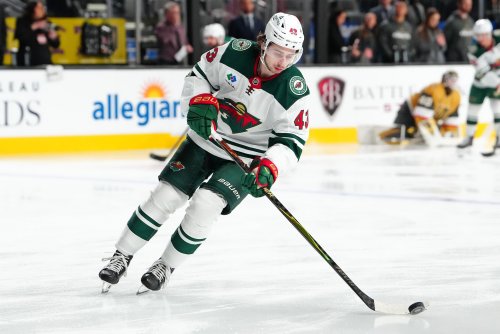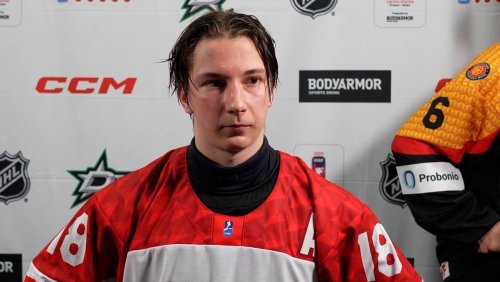.jpg.9c7ff84d5ea4274f9c9809cd5102cf54.jpg)
Let me get this out of the way: I like the Yakov Trenin contract -- in a vacuum.
Minnesota signed the 27-year-old forward to a four-year, $3.5 million per year deal in free agency. The sixth-year winger has built a reputation as an effective defensive player. He’s also heralded as an elite penalty killer.
The numbers also back up that reputation. The Athletic’s analytical model gives him a minus-1 net rating, just below average. That value implies he’s some kind of middle-six forward. Digging deeper into those numbers, it’s clear that Trenin’s elite defense and penalty kill contributions make up for his offensive limitations. That makes him a middle-of-the-lineup player with value, specifically in his own end.

Notably, Trenin can drive play despite playing against challenging opponents. He typically plays against 59th-percentile competition, meaning he plays against the other team's second line on an average night. Posting excellent defensive numbers with those assignments will be a massive advantage for the Wild coaching staff.
The only flaw in Trenin’s game is that he’s not very talented with the puck, which is clear on his player card. His goal and assist numbers come in way below his expected goals (xGoals) offensive impact. That means Trenin and his linemates get plenty of chances, but his shots and passes aren’t very good. They’re at or below fourth-line quality.
That won’t affect Trenin’s playing time because scoring won’t be his role. It would be nice if he had some offensive ability, but he would have cost much more if he could score.
Speaking of market value, that's also reasonable on Trenin's deal. Even with the offensive warts in his game, The Athletic’s analytical model estimated Trenin’s on-ice value at $3 million per year. The Wild will pay him a bit more than that, but that’s common for an unrestricted free agent like Trenin. On top of that, Minnesota desperately needs better penalty killers, especially with Mason Shaw’s departure.
So what’s the issue?
Trenin doesn’t address the team’s secondary scoring, which is the lineup’s greatest shortcoming at five-on-five. The Wild gave up on their second line last year, loading up the top line in hopes it could carry the offense by itself. It’s also why they offered to trade for Patrik Laine.
Guerin used Minnesota’s minimal cap space on Trenin to improve this season’s lineup. But Trenin’s role won’t create secondary scoring and won’t free up anybody to provide that secondary scoring.
Outside of the three-headed monster from last year’s top line, Minnesota has seven players who could realistically fill out the top six: Mats Zuccarello, Ryan Hartman, Marco Rossi, Marcus Johansson, Marcus Foligno, and Freddy Gaudreau. Adding Trenin to that group won’t free up a player from a bottom-six role into a second-line role.
Trenin won’t help the team score, even indirectly, by joining the third line. The only top-six combination that the coaches could try this year that they didn’t last year would be shifting Hartman to the wing so that Rossi can fill in at center while keeping Eriksson Ek on the top two lines. They never tried that last year. If they decide to do so this year, it won’t have much to do with Trenin’s addition. If rookie Liam Ohgren cracks the second line, it still won’t be because the team added Trenin.
That’s essentially the decision that Guerin made when he signed the Russian winger. Unless they luck into internal improvements or better health, the secondary scoring problem will go unaddressed in 2024-25. Trenin’s value is clear: He’s here to help the penalty kill.
John Hynes has prioritized the penalty kill in his last two coaching hires. In November, he elevated assistant coach Pat Dwyer from AHL Iowa to help with the PK. Hynes doubled down on that when he hired Jack Capuano this summer. Per Michael Russo, Capuano and Dwyer will “run the penalty kill in tandem.”
Imagine bringing in two assistants for the express purpose of improving the penalty kill and giving them zero support to make that change via lineup improvements. That wouldn’t make much sense, especially given the aggressive strategic changes that Dwyer and Capuano want to implement.
The Athletic reported that the coaches have made three main changes in camp:
- An “aggressive” neutral zone scheme designed to stop opposing power plays at Minnesota’s blue line.
- Identifying “pressure points” in the defensive zone.
- Limiting chances from the slot.
The first two points will be very demanding for the penalty kill forwards. Outnumbered, they will have to pressure the opposing puck carrier into a bad decision. That requires a unique combination of skating and awareness typically only found in PK specialists such as Joel Eriksson Ek, Marcus Foligno, and Trenin. The coaches can't implement these schematic improvements without adding the personnel who can handle those demands.
So, considering that Minnesota’s next-best option was to ice a terrible PK unit for 2024-25, you could argue that this is a good deal in Year 1. The deal expires after Trenin’s age-31 season, so the team won’t be stuck paying him long after his prime. He’ll be a contributor in his specific role, even if that means he’s a bit overpaid. That’s useful on an NHL roster.
Ultimately, signing Trenin clearly indicates Guerin and Hynes’s priorities. They chose to address the shorthanded unit rather than take pressure off of the top line. There’s nothing to do now but get used to it and hope that’s what the team needs to win more games.
Think you could write a story like this? Hockey Wilderness wants you to develop your voice, find an audience, and we'll pay you to do it. Just fill out this form.
-
 1
1
-
 1
1






Recommended Comments
Join the conversation
You can post now and register later. If you have an account, sign in now to post with your account.
Note: Your post will require moderator approval before it will be visible.